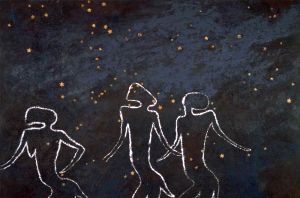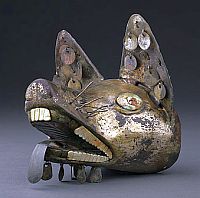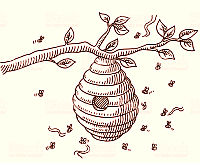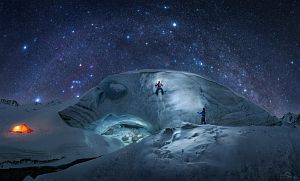


|
|
The Milky WayStar LorePart 3 - Southern Hemisphere |
|
| Emu in the Sky |


The Milky Way is our home galaxy. Our sun is one of an estimated
100 to 400 billion stars in this galaxy.
 The Milky Way is much more prominent in the southern hemisphere, making it a key part of star lore in many cultures in the southern hemisphere. for example, both the Aboriginals in Australia and the Inca in South America saw distinctive patterns in dark patches caused by nebulae along the Milky Way. |


| Southern Africa |


|
|
Khoe-Sān
Khoe-Sān is a generic term for all of the "non-Bantu" indigenous peoples of Southern Africa. In a myth
told in the Kalahari Desert, long ago there were no stars and the night was pitch black until a
girl threw glowing embers into the night sky, where they remained as a wide, shimmering pathway illuminating the celestial firmament: the Milky Way.
|
 Dancing Girls © Gavin Jantjes
Dancing Girls © Gavin Jantjes
|
South African painter Gavin Jantjes captured a scene of dancing girls. To set the historic frame of deep time,
he rendered the dancing figures in a style reminiscent of southern Africa's ancient rock paintings.
 Sources: Smithsonian Institute, Wikipedia |


|
|
!Kung
The Coalsack Nebula is the most prominent dark nebula in the skies,
visible to the naked eye near the Southern Cross, as a dark patch obscuring a brief section of the Milky Way.
|


| Australia |


|
| Dark Constellations of Australian Aboriginal |

 Emu
Emu© Jessica Gullberg |
 Kangaroo
Kangaroo© Jessica Gullberg |
 Uluru & Milky Way
Uluru & Milky Way© Isaak Schiller |

In A Comparison of Dark Constellations of the Milky Way,
Steven R. Gullberg et al. provides a good description of the patterns seen by Aboriginal people:
 "Emu in the Sky” is perhaps the best-known Aboriginal constellation ... It comprises dark nebulae within the plane of the Milky Way. The Coalsack Nebula, near the Southern Cross, forms the head, and the body extends along the Milky Way, outlined by the galactic bulge through the constellations of Scorpius and Sagittarius. ...  In traditions of the Kamilaroi and Euahlayi people of northern New South Wales, the position of the celestial emu at dusk throughout the year denotes the animal’s behavior patterns and seasonal change, and is linked with initiation ceremonies.  Source: Steven R. Gullberg et al. |
 Emu Rock Art in Ku-ring-gai Chase National Park, Sydney
Emu Rock Art in Ku-ring-gai Chase National Park, SydneySource: sydneyoutback.rezdy.com |
 Emu in the sky and on the rocks
Emu in the sky and on the rocks© Barnaby Norris |

The dark nebulae in the Milky Way below the Emu in the Sky
are said by certain cultures to represent a kangaroo.
 Beyond the kangaroo, a section of the Milky Way was thought by some to represent crocodiles. The Crocodiles first become visible in late summer. When the Emu and the Kangaroo have disappeared, the Crocodiles emerge instead. The belly of the Emu becomes the first Crocodile’s head. Certain Aborigines see the Crocodiles lying in the river of the Milky Way and use this to time ceremonial travel in September and October.  Source: Steven R. Gullberg et al. A Comparison of Dark Constellations of the Milky Way |


|
|
Wardaman
Australian writer W. E. Harney reports that to the Wardaman people of the
Northern Territory, the Coalsack Nebula represents head and shoulders of a law-man watching the people to ensure they do not break traditional law.
|
 Crux and Coalsack Nebula
Crux and Coalsack Nebula© amazingsky.net |

|
|
Western Kimberley
The Aboriginal people of Western Kimberley in Western Australia call
the dark patch in the Milky Way between Centaurus and Scorpio Galalang, an ancestral hero who lives in the dark patch.
|
 Dark patches near α and β Centauri
Dark patches near α and β Centauri© amazingsky.net |


| South America |


|
|
Dark Constellations of the Inca (South America) |

The dark constellations of the Incas stretch across nearly 150° of the Milky Way’s expanse. Most are animals that figure prominently in Andean
cosmology and myth.
 Gary Urton relates that the Spanish chronicler Polo de Ondegardo found the Incas to believe that “the animal constellations were responsible for the procreation and augmentation of their animal counterparts on the earth.  |
 Dark Constellations of the Inca;
Source: Somnium Project
Dark Constellations of the Inca;
Source: Somnium Project
|
|
Sources: Gary Urton: At the Crossroads of the Earth and the Sky: An Andean Cosmology Steven R. Gullberg et al. A Comparison of Dark Constellations of the Milky Way Gullberg, Steven Roland: The cosmology of Inca huacas. The following descriptions of Inca Dark Constellations are quoted from A Comparison of Dark Constellations...
|

Mach'acuay - the Snake
 Serpents figure prominently in Inca cosmology and are the creatures representing Uchu Pacha, the underworld and lowest of the three worlds of Inca existence. Machacuay leads this dark celestial procession as the constellations move left to right across the night sky.  Van de Guchte says that the amaru, or serpents, emerged from their underworld environs via rivers and are thought to be related to rainbows and to foretell of rain.Machacuay can be seen at the beginning of the rainy season.  The serpent’s dark figure is long like a snake and travels head before the tail. |

|

Hanp’atu - the Toad
 Hanp’atu follows closely behind Machacuay. Toads were thought of as bad omens as they were created by the devil.  Hanp’atu is a much smaller dark section of the Milky Way to the left of the snake. |
 Incan Toad Mortar 15th century
Incan Toad Mortar 15th centurySource: liveauctioneers.com |

Yutu - the Tinamou
 Tinamou are birds indigenous to the Andes and are of very ancient lineage. Yutu, the Tinamou, follows Hanpatu in the Milky Way and likewise is much smaller than Machacuay.  This Yutu is adjacent to what we refer to as the Southern Cross, is at zenith on the December solstice, and nadir on the June solstice. We know Yutu as the Coalsack in Western astronomy. |
 Tinamou;
British Museum
Tinamou;
British Museum
|

Another Inca myth mentions the god Ataguchu. Ataguchu and his
twin brother Piguero are part of the Inca creation myths in which they showed the first people how to escape the underworld.
 In a myth told on the website of the European Southern Observatory, Ataguchu kicked the Milky Way in a fit of anger, causing a fragment to fly off and form the Small Magellanic Cloud. The Coalsack is the black mark left behind where the broken fragment was.  Sources: European Southern Observatory, constellation-guide.com |

Yacana - the Llama
 Llamas figure prominently in many aspects of Inca culture and this celestial figure was thought to animate the llamas on the Earth. Yacana is a constellation much larger than Hanpatu or Yutu and dominates the Incas’ dark constellation section of the Milky Way.  Yacana is situated between Centaurus and Scorpio. The prominent stars Alpha and Beta Centauri serve as the llama’s eyes and as such are known as Llamacñawin, the "eyes of the llama."
Uñallamacha - the Baby Llama
|

|


Atoq - the Fox
 Following Yacana and Uñallamacha in the sky from the left is the somewhat smaller constellation of Atoq, the fox. Atoq lies on the ecliptic between the constellations of Scorpio and Sagittarius and the Sun enters it during the December solstice.  Urton relates that the Milky Way and Atoq catch up and rise with the summer solstice Sun in the southeast during the same period of time that terrestrial baby foxes typically are born. "... the sun rises into [Atoq] ... from about December 15 to December 23." |
 Moche Fox Headdress, 1st cent. AD
Moche Fox Headdress, 1st cent. ADSource: Museo Oro del Perú |

Urton lists a second constellation called Yutu. This additional tinamou follows Atoq and completes the celestial procession.
 Source: Steven R. Gullberg et al. A Comparison of Dark Constellations of the Milky Way Urton also mentions and Inca interpretation of the shiny part of the Milky Way as a heavenly reflection of the sacred Vilcanota River: |

Andean cosmology ties the Milky Way with the Vilcanota River. The Vilcanota flows southeast to northwest through the Sacred Valley, past Machu
Picchu and beyond. Its waters are thought to rise into the Milky Way and, once having traveled its celestial course, fall again to the earth as rain.
 The sun is stronger in the summer because it drinks from the swollen Vilcanota as it travels beneath it at night. It is weaker in the winter because it has had less to drink.  Source: Gary Urton: At the Crossroads of the Earth and the Sky: An Andean Cosmology |
 An illustration of how astronomical phenomena and the sacred mountain & ceremonial center of Machu Picchu could be associated in Inca beliefs
(graphic adapted from Johan Reinhard 2002 / Gary Urton 1981 / Google Earth 2012)
An illustration of how astronomical phenomena and the sacred mountain & ceremonial center of Machu Picchu could be associated in Inca beliefs
(graphic adapted from Johan Reinhard 2002 / Gary Urton 1981 / Google Earth 2012)Source: Peruvian Times |


 |
 Kalapalo (Mato Grosso)
The Kalapalo people in what is now the Brazilian state of Mato Grosso
saw the Coalsack Nebula as a beehivehad and the stars
of the Southern Cross as Aganagi, angry bees that had emerged from the hive.
|
 Bee Hive
Bee HiveSource: clipart.email |


|
|
Mocoví (Gran Chaco)
Alejandro López
relates the cosmology of the Mocoví people of the Gran Chaco area to the the Coalsack Nebula and
a mythical being called the Mañic.
|

|
A Mocoví mythical tale has that a powerful man decided to face the Mañic.
He chased the Mañic throughout the world and the cornered Mañic climbed up the ombú trunk (the tree of the world) to the sky.
 Today, the shadow-soul (la 'al) of the Mañic can be seen in the Milky Way's dark clouds, with its head in what we know as the Coalsack. Alpha and Beta Centauri are dogs chasing the Mañic and bite at its neck."  Source: Steven R. Gullberg et al. A Comparison of Dark Constellations of the Milky Way |
 The Mañic; art by Jessica Gullberg,
The Mañic; art by Jessica Gullberg,constellation from López and Alterlieb Source: researchgate.net |


| Pacific |


|
|
Hawaii
Hawaiian sailors as well as priests and timekeepers (called Kahuna) observed the change in the
orientation of the Milky Way through the night and used it for time determination.
In her book Hawaiian Myths of Earth, Sea, and Sky,
Hawaiian writer Vivian L. Thompson tells the story of the trickster-god
Ka-ulu who created the Milky Way when he defeated the Chief of Sharks.
|

|
"This version holds that Ka-ulu's brother, Ka-ehu, had been abducted by a great king, a chief of Far Island. Ka-ulu
becomes Ka-ulu-the-Strong and decides to find his brother.
 The king fears Ka-ulu, so he sends Great-Rolling-Surf to kill the strong man. Ka-ulu uses his strength to break the Great-Rolling-Surf into little waves.  The king then sends Great-Stone-Man-with-Eight-Foreheads, a giant made of stone. When this giant attacks, Ka-ulu grabs him and holds him down until the ground and grass and trees grow over him. The Great-Stone-Man thus becomes a stone mountain with eight rolling hills.  The king send his Great-Barking-Dog to attack Ka-ulu, but the latter uses his strong hands to break the Great-Barking-Dog into pieces, each of which became a little barking dog that ran off in fear.  Ka-ulu approaches the king's mountain home. The king throws Great-Rock at Ka-ulu as he climbs the mountain. Ka-ulu crushes the Great-Rock into many little pebbles.  |
Ka-ulu then approaches the king and places his strong hands on the king's throat. Threatening the king's life, Ka-ulu asks for the
whereabouts of his brother. The king, a weakling and fearful for his life, tells Ka-ulu to go ask the Chief of Sharks about the
location of Ka-ehu.
 Ka-ulu goes to Chief of Sharks and asks where Ka-ehu can be found. Chief of Sharks tells Ka-ulu that Ka-ehu is inside of his great stomach, but there is room for two if Ka-ulu would like to join him.  Knowing better than to be eaten by a great shark, Ka-ulu grabs the Chief of Sharks by his jaws and pulls them so wide that Ka-ehu can walk out of the shark's stomach. Before Ka-ulu and Ka-ehu leave, Ka-ulu grabs the Chief of Sharks and throws him into the sky. The great shark's body breaks and shatters into millions of pieces, forming the great white streak across the sky that we now know as the Milky Way.  Source: Cosmobiologist |

|

| The pictures above and below are not related to the myths told in any shape or form. I just thought they would be good illustrations. |

In her epic four-volume work Hawaiian Mythology, US-American American folklorist and
ethnographer Martha Beckwith reports shark related myths about the Milky Way from
several places in Polynesia:
 "The king shark of Kane and Kanaloa in Lewa-lani, called Ku-kama-ulu-nui-akea or Kalake‘e-nui-a-Kane, whom Ka-ulu slays in this legend and whose spirit flies up to the Milky Way, has its prototype in the South Seas." |
 Winter Milky Way; © Dr. Nicholas Roemmelt
Winter Milky Way; © Dr. Nicholas Roemmelt
|

|
|
In the Tuamotus, the Milky Way is the sacred ocean of
Kiho-tumu; the dark rift in the
Milky Way is his sacred ship, called The-long-shark.
 Note: US-Aamerican anthropologist Kenneth Emory raised some doubts about the Kiho-tumu myth, that can be found here. |

|
|
In Rarotonga (Cook Islands), Māui kills Te-Mokoroa-i-ata, the water monster who insulted Māui's father Tangaroa, and Mokoroa becomes the Milky Way. |

|
|
In Tahiti, "the handsome blue shark, be-loved of Ta‘aroa," frolics with the children until the gods of the sea warn the brothers Tahi-a-nu‘u and Tahi-a-ra‘i that there is danger of its becoming a man-eater. One breaks his spear between its jaws, the other aims at its heart. They are about to cut it up when Ta‘aroa and Tu snatch away their pet to the Wai-ola-o-Tane and it bathes in the Milky Way. |


|
|
Māori
In Māori, the Milky Way is called Te Māngōroa.
|

|

Another Māori myth regarding the Milky Way is related to Te Waka o Tamarēreti,
Tamarereti’s Canoe, a large Māori constellation consisting of stars of Orion,
Scorpius, the pointer stars of
Centaurus and the
Southern Cross.
 In this legend, Tamarereti, a young warrior creates the night sky. Here is story as written by Rosemary Cole, edited by Audrey Rendle and Judi Miller: 
|
Tamarereti was a young warrior who lived near Lake Taupo. A scary
taniwha, a water monster, lived in the lake, and
Tamarereti knew the taniwha would eat him if he went fishing after dark.
 At the time, the sky was black with no stars but Tamarereti thought he had plenty of daylight to go fishing so he pushed his waka (canoe) out onto the lake. He caught three fish and was heading to the shore to cook his kai (food), when his waka was becalmed. As he waited for the wind to push him back to shore, he slept.  When he awoke he found his wakawaka had drifted to the opposite side of Lake Taupo. He knew he was in big trouble – it was dark, and he was far from his kāinga (village). He was hungry, so he cooked and ate the three fish. As he stood on the edge of the lake, he noticed the lake’s pebbles were reflecting the bright light of his fire, so he collected some of the pebbles and set off to his toi whenua (home), tossing the shiny pebbles into the sky. The pebbles lit his way and their light saved him from the taniwha.  When he got home he slept, but woke to find Rangi-nui had visited him. Tamarereti was terrified that he would be punished for spoiling the perfect blackness of the sky, but Rangi-nui praised him for creating the night sky and tossed Tamarereti’s waka up into the sky as well.  Tamarereti had created the Milky Way.  Source: www.visitzealandia.com |

|


 |
Back to North America | Return to Milky Way Start Page |
 |


|
Back to Star Lore |
Back to Mythology |

Back to Milky Way |
Back to Space Page |
Back to English |
 Back to Start Page |